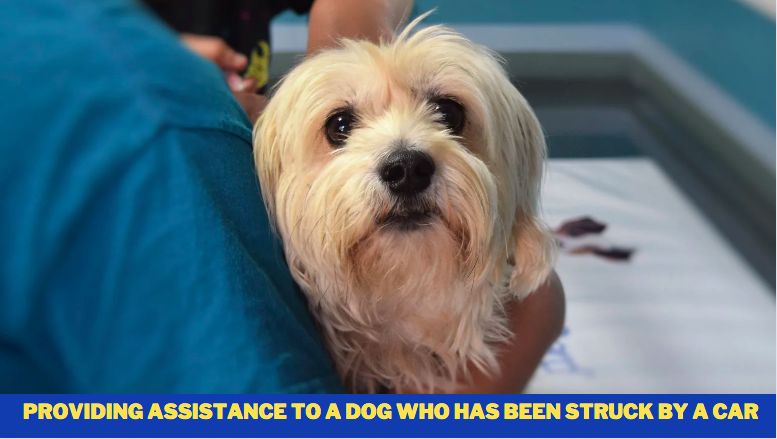Providing assistance to a dog who has been struck by a car
Although the phrase “my dog was hit by a car” is one that no one likes to hear, it happens to pets on a daily basis, which is tragic.
Please continue reading if your dog is struck by a moving vehicle, or if you accidentally strike a dog with your own vehicle, to understand what you should do in this case.
What Should I Do If My Dog Has Been Hit by a Car?
No matter if you’re the dog’s owner, a passerby, or the driver of the vehicle, it’s probable that your first inclination will be to assist the dog, but proceed with caution.
It is possible that moving an injured dog will make the injuries worse. A dog that is hurt, terrified, or disoriented may also be more likely to bite individuals who are attempting to help him. To approach and assist a dog that has been struck by an automobile, follow these steps:
Maintain your composure:
While your emotions may feel out of control, especially if it was your dog that was hit, it is critical that you do not become overly concerned. Not only can keeping a clear head make things easier for you and others assisting you in caring for the dog, but dogs are sensitive to human emotions and look to us for indications on how to feel or react.
Maintaining your composure will assist in soothing the dog and preventing them from panicking and lashing out.
Contact the authorities or animal control:
This is the driver’s obligation, according to PetHelpful, who should remain at the scene until assistance arrives. Left alone without asking for aid or making any attempt to provide care could be considered a hit-and-run, which could subject the driver to criminal prosecution for animal cruelty.
Even if the dog’s owner is there, it is normally advisable that the motorist contact the police and report the occurrence in order to cover all of the bases.
While you’re on the phone with them, inquire as to what they recommend. While the guidelines provided below are intended to be of assistance, it is always advisable to heed the advice of professionals; they may advise you to adopt a different course of action in certain situations.
Installing a muzzle on the dog will help to prevent biting injuries.
In addition, the American Veterinary Medical Association recommends using a stocking, towel, or roll of gauze in the place of a muzzle when one isn’t available.
If one isn’t accessible, the AVMA suggests placing a towel or roll of gauze in the dog’s mouth. A towel or blanket can be used instead of a crate for little dogs; just be careful not to wrap them too tightly and try not to move them more than is absolutely necessary.
In order to avoid a collision, move the dog out of the way.
Only do this if it is possible to do so without endangering your own safety. Otherwise, simply wait for assistance to arrive. A board, blanket, or towel should be carefully placed underneath a large dog to act as a stretcher. The dog should then be gently lifted to the side of the road and placed on a crate or blanket.
Make sure you have the right identification.
You should try to contact the dog’s parent or the veterinarian named on the dog’s identification tag if they aren’t present at the scene and inform them of what has occurred.
If there is no identification and the parent cannot be located, wait for the police or animal control to arrive and take over the situation.
Once you’ve completed these steps, the pet’s owner can determine where the dog should be taken for emergency veterinarian care in the future.
If the dog’s owner cannot be located, either the motorist or a kind stranger may decide to take the dog to the veterinarian as soon as possible.
Keep in mind that by placing the dog in your vehicle, you will be effectively taking control of them, and you may be required to make a down payment to cover the cost of the dog’s veterinary care.
However, if the parent cannot be located, you may be able to recover the charges from them. If the cost is one you cannot afford, it’s best to wait for the police and let them take care of it on their own dime.
Who Is Responsible for the Costs?
As The Balance points out, while responsibility laws varies from one state to the next across the country, in most cases the dog’s owner is responsible for veterinarian charges as well as any damage to the driver’s vehicle. While this may not appear to be totally fair, the reasoning behind it is that it is the parent’s obligation to ensure that their dog is restrained and out of the way of oncoming vehicles.
The only exception is if it can be proven that the motorist was either driving carelessly or intentionally hit the dog, in which case the driver may be accountable for the dog’s value, in which case the driver may not be liable.
Other options include filing a claim with the driver’s auto insurance provider, which will most likely look to the dog parent’s home insurance liability coverage to cover the cost of the claim.
What Happens If the Dog Appears to Be Unharmed?
While it is conceivable for a dog to appear to be unharmed following a collision, it is also possible for a dog to appear to be unharmed while really sustaining major internal damage in the process.
It is important to recognize that in this circumstance, it is necessary to defer to the expertise of the specialists (a veterinarian) in order to determine the status of the dog.
Even if it appears to be a small incidence, the dog should be examined by a veterinarian. Again, if the dog’s parent isn’t accessible to make a decision, it’s better to wait for professional help to arrive and analyze the situation as well as the dog’s physical state before making a decision.
The following are some symptoms to look for in order to assist the veterinarian in determining the health of the dog:
- Heartbeat that is rapid
- Breathing that is shallow
- Diarrhea or feces that are black
- Gums that are pale or blue in color
- Whimpering
- Coughing or vomiting blood is a medical emergency.
- Depression or sluggishness
- Eyes that are glazed or unfocused
- Bruising or scrapes on the skin
- Coma: is a state of unconsciousness.
Taking Care of a Dog Who Has Been Hit by a Vehicle
When you take your dog to the veterinarian, the first goal will be to stabilize your pet, according to PetHelpful.
However, while you may be concerned that your dog’s visible injuries aren’t being properly addressed, it is critical to prevent them from falling into shock before any other treatment can be administered.
The veterinarian will also be concerned with preventing internal bleeding, preventing a heart attack, and preventing your dog from drifting into a coma while treating your dog.
Injuries that are not life-threatening will only be assessed and treated once your dog has regained enough stability to continue.
It is possible that your dog will need to be hospitalized and may require surgery or specialized treatment, depending on the severity of the injuries sustained.
Pet insurance for your dog can assist you in reducing the costs associated with life-saving treatments and post-operative recuperation.
Following the stabilization of your pup and the treatment of all of their injuries, you will be permitted to take them home.
Your veterinarian will offer you advice on how to care for your dog at home, as well as any drugs that may be required to manage discomfort and aid in the recovery of your canine companion.
Preventing Your Dog From Being Hit by a Vehicle
However intelligent or well-trained your dog may be, relying on the training or your dog’s ability to notice approaching vehicles for their safety is not a good idea.
- To ensure that your dog stays off the streets, you must keep them physically bound, either by walking them on a leash or by keeping them in a fenced-in area at all times.
- Make sure that any gaps or weak spots in your fence that could allow your dog to escape are repaired or strengthened. Aside from that, proper obedience training can help to ensure that your dog does not dash out into the street, either tugging you along behind him or tearing the leash out of your hand.
- When walking your dog, it’s a good idea to pay great attention to your surroundings; keep an eye out for approaching traffic and hold on to your dog’s leash as tight as you can.
- The fact that your dog has been hit by a car, or that you have been hit by your dog, is a distressing situation for all parties concerned.
- By remaining calm and acting promptly but cautiously to assist the dog that has been struck by a car, you will boost their chances of survival — and you will have peace of mind knowing that you did everything you could to save them.
Fact-Finding:
Thanks for reading and have a great day! Providing assistance to a dog who has been struck by a car?
Please post your thoughts in the comments section if you have any. Please feel free to share!

